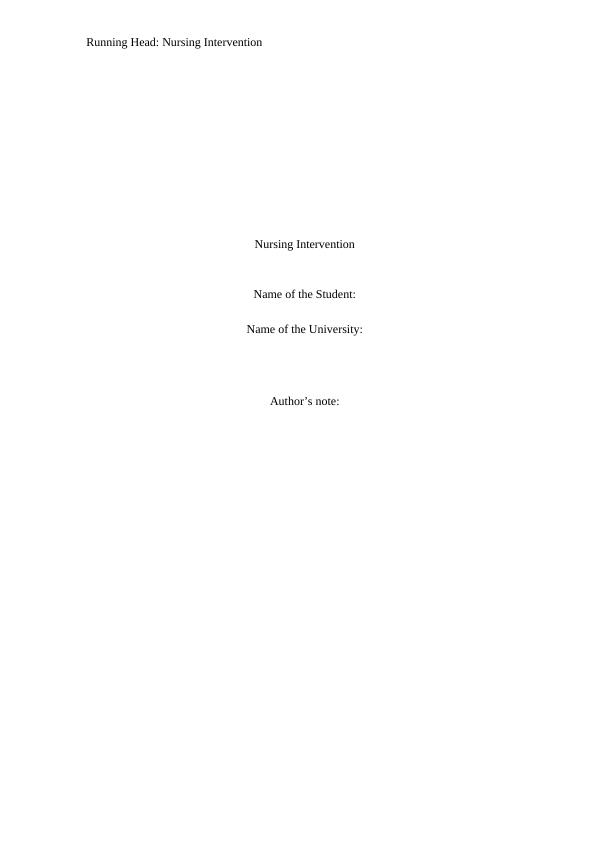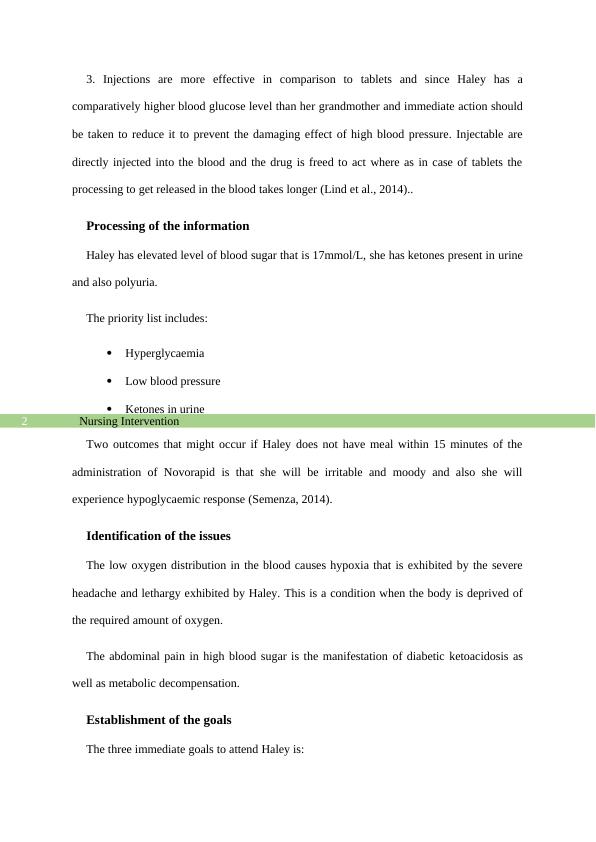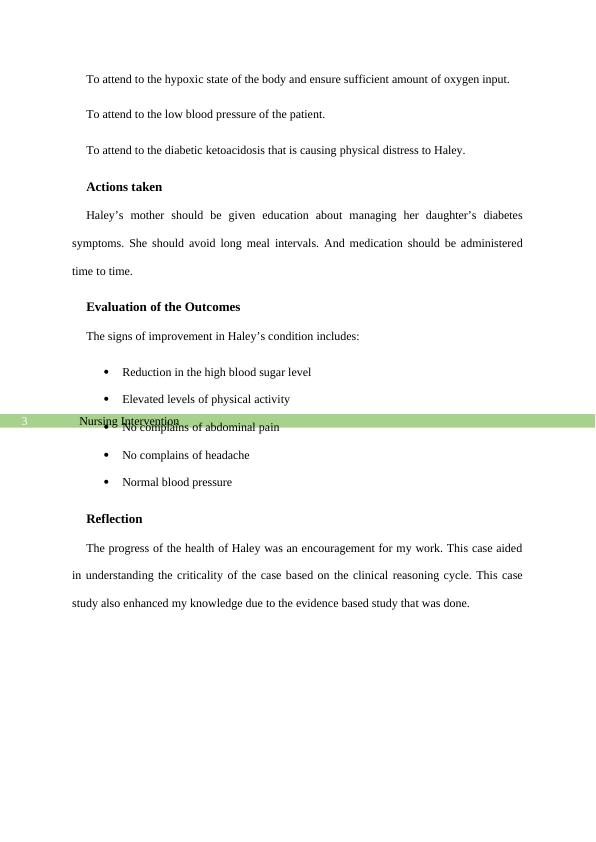Nursing Intervention.
Added on 2022-10-31
13 Pages2543 Words2 Views
Running Head: Nursing Intervention
Nursing Intervention
Name of the Student:
Name of the University:
Author’s note:
Nursing Intervention
Name of the Student:
Name of the University:
Author’s note:

Nursing Intervention1
Case Study 1
Considering the Patient
Initial impression of the patient
Haley is 9 year old she had an evident skin fold that is evident for a single second. She
looks tired and has minimal physical activity. She comparatively had a high rate of
respiration.
More information about Haley
Haley has been presented with a medical history of polyuria and polydipsia. She had a
high blood sugar level. She suffered weight-loss and complained of abdominal pain. She had
a lethargic feeling. Urine test exhibited excess amounts of ketones and glucose.
Information that are significant
The significant information of Haley includes that she is hyperglycaemic. She also
exhibits polyuria and polydipsia.
Collection of the Information
The other information that are required is whether Haley has acquired a skin infections, if
she has a fruity smell breath. If this elevated blood sugar level is not controlled it would lead
to kidney, heart, eye damage in the child. It can also cause nerve damage and osteoporosis
(Atkinson, Eisenbarth & Michels, 2014)..
The pathophysiology of the type 1 diabetes includes destruction of the beta cells of the
pancreas that results in insulin deficiency. This is an autoimmune disorder that causes
ketoacidosis (Marik & Bellomo, 2013).
1. A normal blood glucose level is 4-6mmol/L.
2. All the signs and symptoms pertain to hypoglycaemia except Kussmaul breathing.
Case Study 1
Considering the Patient
Initial impression of the patient
Haley is 9 year old she had an evident skin fold that is evident for a single second. She
looks tired and has minimal physical activity. She comparatively had a high rate of
respiration.
More information about Haley
Haley has been presented with a medical history of polyuria and polydipsia. She had a
high blood sugar level. She suffered weight-loss and complained of abdominal pain. She had
a lethargic feeling. Urine test exhibited excess amounts of ketones and glucose.
Information that are significant
The significant information of Haley includes that she is hyperglycaemic. She also
exhibits polyuria and polydipsia.
Collection of the Information
The other information that are required is whether Haley has acquired a skin infections, if
she has a fruity smell breath. If this elevated blood sugar level is not controlled it would lead
to kidney, heart, eye damage in the child. It can also cause nerve damage and osteoporosis
(Atkinson, Eisenbarth & Michels, 2014)..
The pathophysiology of the type 1 diabetes includes destruction of the beta cells of the
pancreas that results in insulin deficiency. This is an autoimmune disorder that causes
ketoacidosis (Marik & Bellomo, 2013).
1. A normal blood glucose level is 4-6mmol/L.
2. All the signs and symptoms pertain to hypoglycaemia except Kussmaul breathing.

Nursing Intervention2
3. Injections are more effective in comparison to tablets and since Haley has a
comparatively higher blood glucose level than her grandmother and immediate action should
be taken to reduce it to prevent the damaging effect of high blood pressure. Injectable are
directly injected into the blood and the drug is freed to act where as in case of tablets the
processing to get released in the blood takes longer (Lind et al., 2014)..
Processing of the information
Haley has elevated level of blood sugar that is 17mmol/L, she has ketones present in urine
and also polyuria.
The priority list includes:
Hyperglycaemia
Low blood pressure
Ketones in urine
Two outcomes that might occur if Haley does not have meal within 15 minutes of the
administration of Novorapid is that she will be irritable and moody and also she will
experience hypoglycaemic response (Semenza, 2014).
Identification of the issues
The low oxygen distribution in the blood causes hypoxia that is exhibited by the severe
headache and lethargy exhibited by Haley. This is a condition when the body is deprived of
the required amount of oxygen.
The abdominal pain in high blood sugar is the manifestation of diabetic ketoacidosis as
well as metabolic decompensation.
Establishment of the goals
The three immediate goals to attend Haley is:
3. Injections are more effective in comparison to tablets and since Haley has a
comparatively higher blood glucose level than her grandmother and immediate action should
be taken to reduce it to prevent the damaging effect of high blood pressure. Injectable are
directly injected into the blood and the drug is freed to act where as in case of tablets the
processing to get released in the blood takes longer (Lind et al., 2014)..
Processing of the information
Haley has elevated level of blood sugar that is 17mmol/L, she has ketones present in urine
and also polyuria.
The priority list includes:
Hyperglycaemia
Low blood pressure
Ketones in urine
Two outcomes that might occur if Haley does not have meal within 15 minutes of the
administration of Novorapid is that she will be irritable and moody and also she will
experience hypoglycaemic response (Semenza, 2014).
Identification of the issues
The low oxygen distribution in the blood causes hypoxia that is exhibited by the severe
headache and lethargy exhibited by Haley. This is a condition when the body is deprived of
the required amount of oxygen.
The abdominal pain in high blood sugar is the manifestation of diabetic ketoacidosis as
well as metabolic decompensation.
Establishment of the goals
The three immediate goals to attend Haley is:

Nursing Intervention3
To attend to the hypoxic state of the body and ensure sufficient amount of oxygen input.
To attend to the low blood pressure of the patient.
To attend to the diabetic ketoacidosis that is causing physical distress to Haley.
Actions taken
Haley’s mother should be given education about managing her daughter’s diabetes
symptoms. She should avoid long meal intervals. And medication should be administered
time to time.
Evaluation of the Outcomes
The signs of improvement in Haley’s condition includes:
Reduction in the high blood sugar level
Elevated levels of physical activity
No complains of abdominal pain
No complains of headache
Normal blood pressure
Reflection
The progress of the health of Haley was an encouragement for my work. This case aided
in understanding the criticality of the case based on the clinical reasoning cycle. This case
study also enhanced my knowledge due to the evidence based study that was done.
To attend to the hypoxic state of the body and ensure sufficient amount of oxygen input.
To attend to the low blood pressure of the patient.
To attend to the diabetic ketoacidosis that is causing physical distress to Haley.
Actions taken
Haley’s mother should be given education about managing her daughter’s diabetes
symptoms. She should avoid long meal intervals. And medication should be administered
time to time.
Evaluation of the Outcomes
The signs of improvement in Haley’s condition includes:
Reduction in the high blood sugar level
Elevated levels of physical activity
No complains of abdominal pain
No complains of headache
Normal blood pressure
Reflection
The progress of the health of Haley was an encouragement for my work. This case aided
in understanding the criticality of the case based on the clinical reasoning cycle. This case
study also enhanced my knowledge due to the evidence based study that was done.

End of preview
Want to access all the pages? Upload your documents or become a member.
Related Documents
Case Study Based Nursing Assignmentlg...
|11
|3185
|12
Health Care - Diabetic Ketoacidosislg...
|7
|1587
|21
CLINICAL REASONING CYCLE CASE STUDY 2022lg...
|11
|2643
|30
Idiopathic Thrombocytopenic Purpura (ITP) | Case Studylg...
|8
|1493
|40
Nursing Practise Assignment 2022lg...
|9
|1971
|11
Case Study on Diabetic Ketoacidosislg...
|5
|1163
|87
